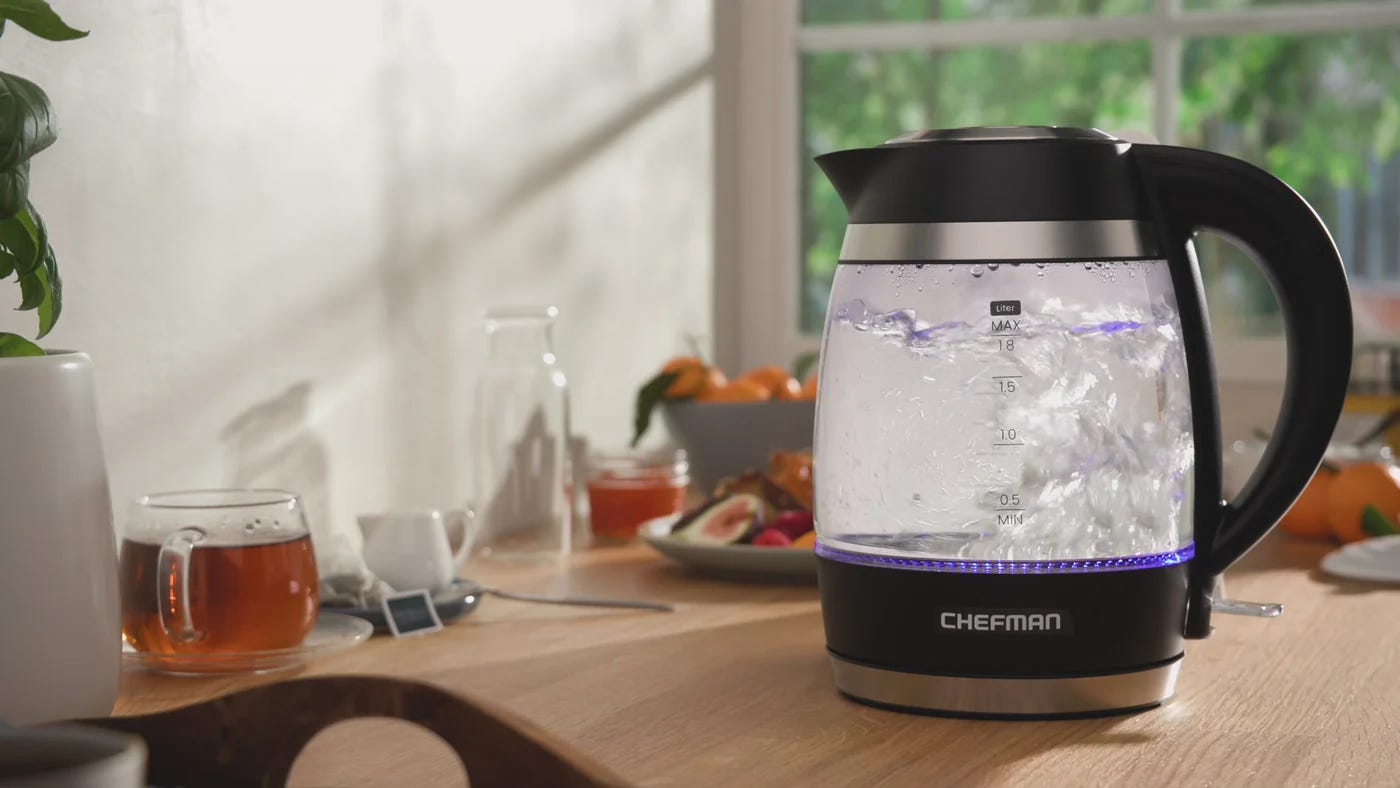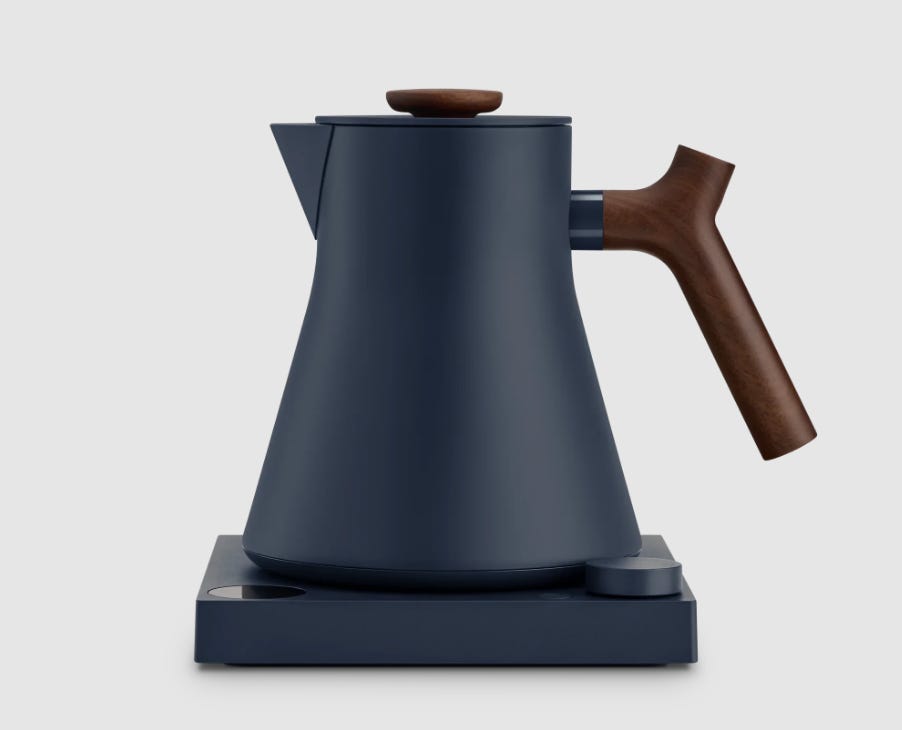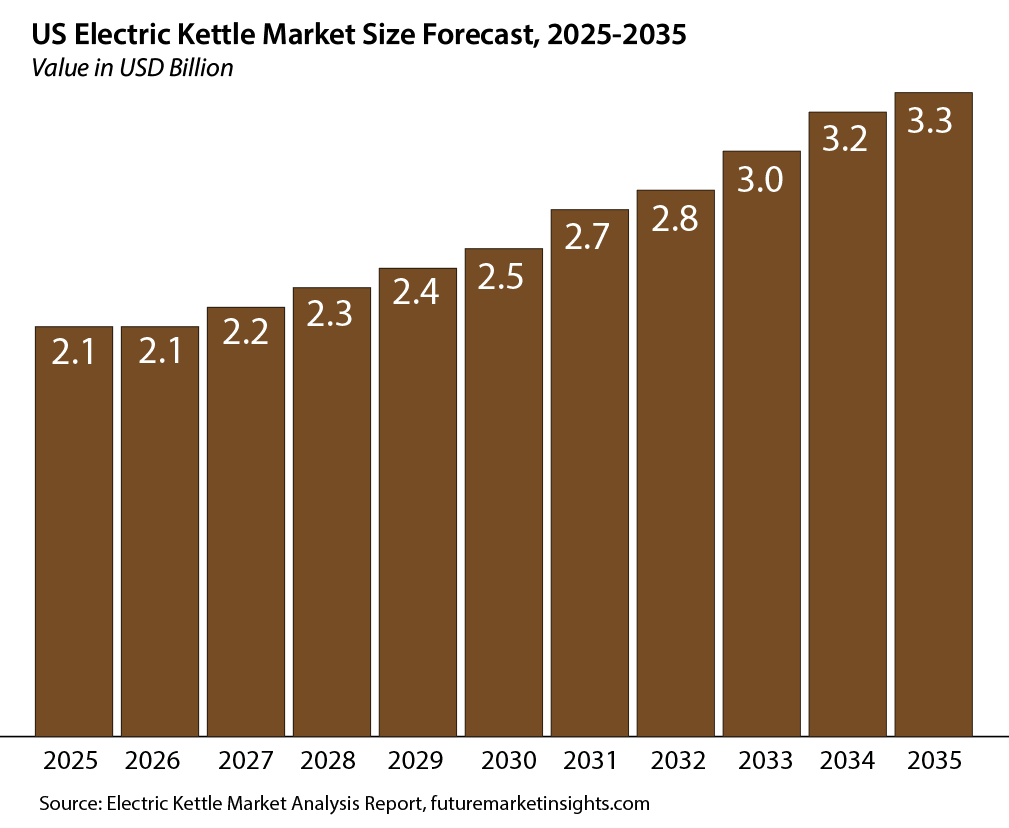Electric kettles take America: Shoddy Goods 063
Why this overseas fixture is finally catching on
After decades as a Midwesterner, I moved overseas in my 40s. And I discovered that every kitchen there had one appliance on the counter that I’d never owned. I’m Jason Toon and in this issue of Shoddy Goods, the newsletter from Meh about consumer culture, I discover that that item has followed my migration path in reverse.
Like Oasis and the phrase "spot on," another venerable staple of British life is belatedly winning over America: the electric kettle. If the invasion hasn't reached your kitchen yet, an electric kettle is basically a pitcher that you plug in and it heats water. They're a routine appliance, not just in the UK but across the rest of the developed world.
Personally, I had never seen one outside of a hotel room until I moved from the USA to Australia eight years ago. But after searching in vain for a stovetop kettle, we gave it a try and quickly saw the advantage. I had once foolishly dismissed it as a unitasker, which I guess is technically accurate. But when that one task is as broad as boiling water, quickly, easily, without messing with a stove or microwave, and with no risk if you forget about it, the electric kettle earns its space on our counter.
America's most popular electric kettle, probably because of the purple lights
"Can't imagine living without one"
We're not the only Yanks who've been turned into believers. This year, electric kettles have been ready for their media close-up. "If you would have asked me a year ago if I needed an electric kettle, I would have replied with a quick and emphatic no!" wrote Bon Appetit's Emily Farris last month. "I don’t drink much tea and I’m not a pour-over coffee person, so to me it just seemed like yet another unnecessary waste of valuable counter space… Now I can’t imagine living without one."
Other big media outlets joining the electric kettle queue included Wired, with a tech-hipster slant to its kettle love: "The new generation of electric kettles can stop at a dime at the precise temperature that brings out the best flavors in green or oolong tea, or a light-roast bean from one of our favorite coffee subscriptions." Esquire drooled over their favorite model, the Fellow Corvo EKG, complete with sultry gadget-porn photos: "I originally purchased this based on looks, only to realize later that it actually functions great too."
The water's not the only thing heating up in here, huh, Esquire?
Meanwhile, Good Housekeeping assured good housewives that "electric kettles can be used for everything from making hot oatmeal to brewing pour-over coffee, all within minutes — much quicker than most stovetop models". When Reader's Digest recommends a product as a gift for Grandpa, you know the phenomenon has gone fully mainstream.
"Permanently out on the counter"
How long has this been going on? Was my memory of an electric-kettle-free America merely the outdated memory of an out-of-touch expat?
A quick canvass of my Stateside friends found that yes, the teatimes they are a-changin'. A few had picked up the habit long ago on trips abroad. "My first time depending on them was in 1993, working at a hotel in Ireland," one said. "It was hard to live without one after that. I like the instant gratification of the noise they make when they start to heat up. It's definitely part of a ritual."
More commonly, my friends had been using theirs for anywhere from two to ten years. The sheer variety of uses gives the lie to the unitasker label, from standards like making tea, oatmeal, and soup to more inventive lifehacks like unclogging the toilet, filling a pedi-spa, and thawing an outdoor birdbath in cold weather.
A few had tried one out and found they could live without it, but for most, it was now "a permanently out (on the counter) item." Another friend said, "Super passionate American electric kettle family here. We survive winter by using it nightly to fill Fashy brand hot water bottles."
As nerds love to say, anecdotes aren't data. So how about a graph? A report by Future Market Insights forecasts the US electric kettle market will grow by 57% over the next ten years. "Growth is reinforced by health and lifestyle trends favoring home brewing for coffee and herbal teas."
The water's not the only thing hea- oh, wait, we did that joke already
What took so long?
OK, so people love them and they're super-useful. Why weren't they in American homes long ago? It hasn't been long since the online conversation was about why electric kettles hadn't caught on in America. Most of the answers don't really ring true.
Some say it's because the US standard household voltage of 120 V is lower than the 220-240 V in the rest of the world, so electric kettles in the US are slower and the time savings aren't as great. But then why are they so common in Japan, whose 100 V household voltage is among the lowest in the world?
Because they drink tea, like the electric-kettle-loving British, you might say. Beverage preference doesn't explain extensive electric-kettle penetration in places like France and Germany, also more coffee-friendly territory.
My guess is that, like me and the Bon Appetit writer, most Americans have just assumed electric kettles were much ado about not much, more trouble than they're worth (or more space, anyway), and haven't bothered. But all the evidence points to that longstanding misconception dissolving like a packet of instant soup - or muscle tension in a piping hot pedi-spa.
I do a pour-over from my electric kettle into a ChemEx pitcher using YesPlz coffee beans. It all tastes great, but the simple and patient routine of it all is a big reason I stick to it - it’s almost a little meditative. What’s your go-to morning routine like, especially drink-wise? Let’s hear about it in this week’s Shoddy Goods chat.
—Dave (and the rest of Meh)
Pour yourself a nice hot water bottle and curl up with these cozy Shoddy Goods stories past:




